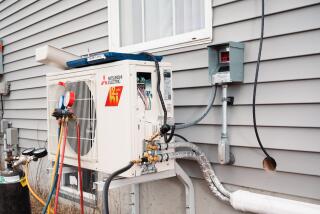You don’t need to spend big bucks to make your home greener
- Share via
Reporting from Washington — Homeowners who believe they’ve been left out of the so-called green movement have every reason to feel that way.
Until recently, the effort to reduce the environmental impact of housing has been concentrated on new construction. But even now that green has found the remodeling sector, owners for the most part still have to spend big money to make their homes more energy efficient. Worse, the payback often is not enough to warrant the expense, even when Uncle Sam chips in a tax credit or two.
A case in point is Honeywell International Inc.’s new rooftop wind turbine. Just 6 feet tall, the little windmill was the highlight of the recent International Builders Show in Las Vegas because it promises to bring wind power to the masses. The lightweight rig can generate energy at wind speeds of just 2 mph.
Honeywell says the turbine is the highest-output, lowest-cost-per-kilowatt-hour installed unit ever made for its class and size. But at $5,995 a pop, it will be a long time before the windmill pays for itself. Honeywell says it can produce as much as 2,000 kilowatt-hours of energy a year, which is about 18% of the average household’s use. But that assumes an average wind speed of 12.3 mph, when 90% of the country’s wind resources are below 9 mph on average.
This isn’t to single out Honeywell. There are dozens of innovative products that hold great promise, but the return may not be worth the investment. At the same time, though, there are cost-efficient things any owner can do to save energy and money.
Toilets are one place owners can help save Mother Earth, not to mention some cash, without having to rip out the current commodes. Instead, consider retrofitting with a conversion kit that turns a standard water waster into an eco-friendly, high-efficiency, dual-flush model.
New dual-flush toilets can run $500 to $700, but the One2flush conversion kit retails for just $34.95 and can cut water usage 40%. The manufacturer claims the typical family can save 30 gallons a day, which equates to more than 10,000 gallons a year or the size of a 27-foot-long swimming pool.
The kit fits all standard two-piece toilets. Once installed, the handle goes one way for a half-flush and the other way for a full flush. (A similar product, HydroRight by MJSI Inc. in Shorewood, Ill., works the same way, except a button replaces the handle. Retail price: $24.99.)
If you are more ambitious, you can replace your entire tank with a WOW Toilet, which not only comes in a dual-flush model ($89.95) but also is clear for a decorating change of pace.
Replacing your light bulbs and/or fixtures also can save some money. According to a recent Harris Interactive survey, 63% of Americans have already installed energy-efficient light bulbs. Chances are they’ve switched to compact fluorescent light bulbs. But light-emitting diode bulbs are rapidly overtaking CFLs.
Just as CFL bulbs are more expensive than incandescent bulbs, LED bulbs are more costly than CFLs -- as much as 40 times the price of a compact fluorescent. But they use about one-fifth the energy and last up to 10 times longer than a CFL and 60 times longer than a typical incandescent.
Not all LEDs are designed well, but the good ones produce far less heat than incandescent bulbs, so cooling costs are reduced.
If all the country’s recessed lights were converted to LED fixtures, the Energy Department says, the energy saved would equal the output of 13 large power plants, or enough to power 6.7 million households. No wonder the agency calls LED “a revolution in lighting.”
Money can also be saved by covering up the hole in your ceiling that leads to the attic. Frequently, the space is not insulated because access stairs fold down from it. But there are several products on the market that can reduce air infiltration, perhaps by as much as 70%.
The Attic Stairway Insulator Cover by Battic starts at $29.50. The Attic Tent from Insulsure Inc. begins at $199.95. ESS Energy Products has two choices: a pull-down ladder cover at $185 and a push-up hatch cover at $260. And Owens Corning chimes in with an Attic Stairway Insulator at $42.
Distributed by United Feature Syndicate.
More to Read
Inside the business of entertainment
The Wide Shot brings you news, analysis and insights on everything from streaming wars to production — and what it all means for the future.
You may occasionally receive promotional content from the Los Angeles Times.









